Last updated on 24th November 2023
Do you often find yourself drowning in a sea of never-ending to-do lists, desperately trying to juggle multiple tasks at once?
Well, fret no more because we’ve got the ultimate time management hack that will skyrocket your productivity and have you checking off tasks like a well-oiled machine!
Get ready to embrace the power of time blocking and unlock the hidden potential of your day.
In this article, we’ll guide you through the art of effectively allocating your precious time, maximising focus, and achieving more than you ever thought possible.
Say goodbye to distractions and hello to laser-like concentration as we dive into the secrets of mastering time blocking. Get ready to reclaim your productivity and conquer your goals, one blocked-out moment at a time!
What is time blocking?
Time blocking is a time management strategy that focuses on scheduling out all of your tasks in order to help you discover where improvements can be made, and ultimately help you pack as much as possible into your working day.
You can use time blocking to manage your day-to-day tasks, but also to help you chip away at those bigger, future goals – such as writing a book, or gaining a new qualification.
Here’s an example of a day in the life of someone who uses time blocking:

As you can see, time has not only been set aside for work tasks but also the smaller details of the day, such as commuting to and from work, and coffee breaks. Scheduling in moments like this gives you a more accurate view of your day and ensures you aren’t blocking out your time with unrealistic expectations.
Another way to avoid over-scheduling is to include buffer time. Buffer time is a couple of minutes (usually 10-15) between tasks. You can use this to deal with those pesky little errands that pop up throughout the day. Or, better yet, you can use this as a time to reset your brain between tasks – which can have a positive effect on productivity.
A study by the Draugiem Group, a collection of Latvian companies, found that their most productive employees didn’t actually work more hours than others, they simply took more breaks. On average, the high-productivity group worked for 52 minutes and then took a 17 minute break.
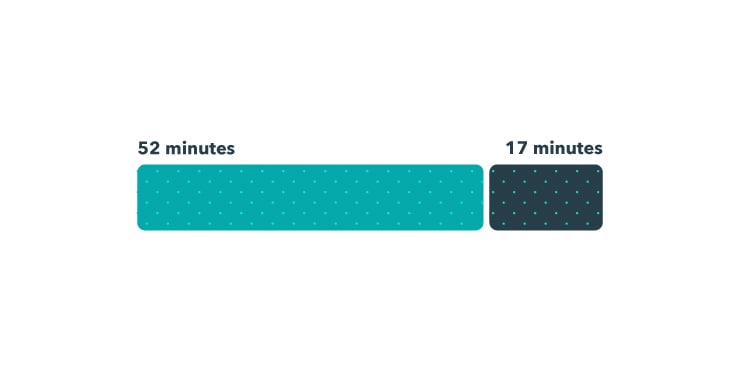
How to get stuff done with time blocking
Now that you have a good grasp on what time blocking is, let’s talk about how you can implement it into your day and start getting stuff done!
One of the best things about time blocking is that it can work for anyone, in any industry. From freelancers to agencies, from one-man teams to enterprises – time blocking is for everyone. You can even start using it to get more out of your weekends.
We’ve used Google Calendar to demonstrate time blocking because it’s free and easy to use, but you should be able to do this in most calendar apps. To add time entries, all you need to do is click on the date and enter your data:
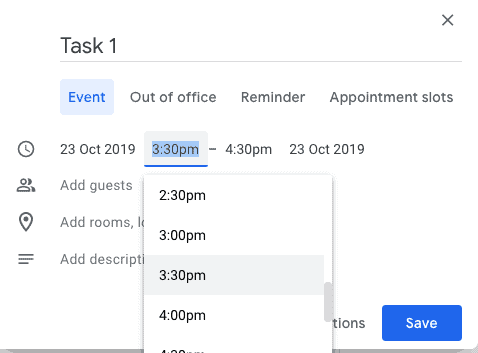
The app is also really intuitive and able to link images to certain tasks:
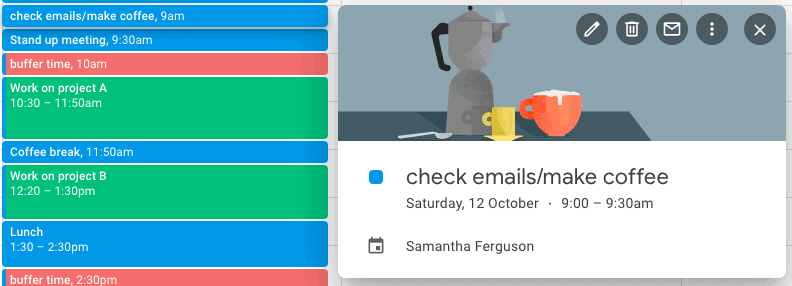
You can also set alerts within Google Calendar so you know when it’s time to move on to your next task – much better than checking the clock!

The first step towards blocking out your day is to schedule in all of your regular tasks. These are the things you do every day without fail. Here’s an example:

Notice that we’ve included time to check emails and eat lunch – it’s important to account for everything in order to better understand your schedule and ensure you’re getting the most out of your day. Being realistic also makes you much more likely to stick to your routine.
Next, fill the time that you have left with the tasks you would like to complete or work on over the course of the day. It’s important to understand how you work best in order to be more productive. For example, if you are more productive when you get lost in a task (by spending hours of uninterrupted time on it) then schedule your time to reflect that. If you struggle to concentrate for long periods, then schedule your tasks in for shorter time frames.
If you think you’d benefit from regularly switching between tasks, then the Pomodoro technique could be great for your time management. Named after a tomato-shaped kitchen timer, the Pomodoro technique is the process of working for 25 minutes and then taking a 5 minute break.
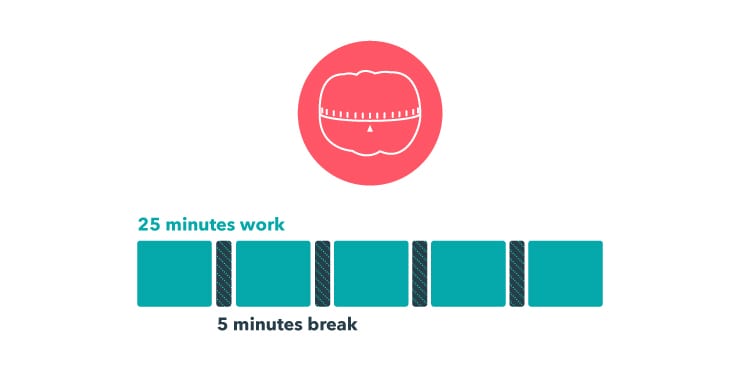
The idea behind this is that you’ll be able to give your full attention to your task, knowing that you have a 5 minute break coming up. Any potential distractions can wait until your break. If this sounds like the technique for you, here’s a useful, online ‘tomato timer’ that you can use to block out your time.
After scheduling in your regular tasks and your tasks for the day (along with your buffer time!), your calendar should look something like this:
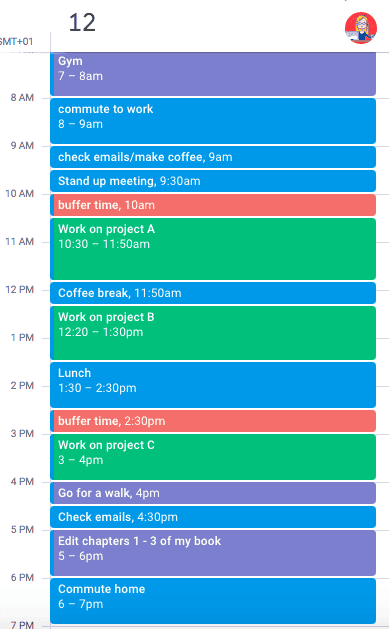
We’ve used a colour code to differentiate between tasks:
- Blue = Regular tasks
- Green = Tasks for the day
- Pink = Buffer time
- Purple = Self-improvement tasks
You can obviously add to this and block your time from sunup to sundown, if that’s what you want. But remember to be realistic and schedule in time to relax. Time blocking is supposed to help you get the most out of your day, not encourage you to fill every single minute with work until you burn out – be kind to yourself!
4 Benefits of time blocking
In addition to giving you a better overview of where all your time is going, here are 4 more benefits of time blocking…
1. Improved productivity
When you have control of your time, you have control of your productivity. It’s as simple as that.
Time blocking forces you to evaluate your daily tasks and then empowers you to organise them in the most efficient way possible – maximising your productivity.
2. Eliminate distractions
By blocking out your time, you can reduce the temptation to seek out distractions. After all, if you’ve blocked out a certain amount of time for a task then that allows no time for procrastination – such as browsing social media or checking your emails. There’ll be plenty of time for that later.
In fact, to further boost the effectiveness of time blocking you should remove all distractions while you’re working – close your email tab, turn off your phone, put your Rubik’s cube in a drawer!
But don’t forget about your buffer time. It’s unrealistic to expect to concentrate all day without breaks, so it’s important to schedule in time to procrastinate – this can be going for a walk, scrolling through Instagram, or whatever you do to unwind.
3. Minimise mental pressure
Switching between tasks is potentially harmful for our brains – and with distractions everywhere, the human attention span is shrinking rapidly.
According to a study by Inc., heavily multitasking can actually lower your IQ by up to 15 points! If that wasn’t bad enough, it takes an average of 25 minutes to resume a task after being interrupted.
Time blocking can help you combat this. By laying out exactly what you plan to work on over the course of the day, you can stay focused and minimise potential interruptions.
4. Be happier!
Productivity and happiness go hand in hand. After all, when you’ve finished a hard day of work and you know that you’ve checked off all of your tasks for the day, you’re rewarded with a great sense of accomplishment. And you can also enjoy your free time without any guilt!
Improving your time management will also get you one step closer to achieving your long-term goals – increasing your happiness even further.
Final thoughts
There are many benefits of using time blocking to take control of your day. But to truly accelerate the productivity of your business, it’s important that everyone on your team uses their time to the best of their ability.
One of the greatest features of Project.co is that you can allocate and record time on every single project, ensuring maximum productivity and profitability. This means you and your team can clearly see which clients and projects are taking up your time. Get started with a free account today to see how much more productive it will make your business!


